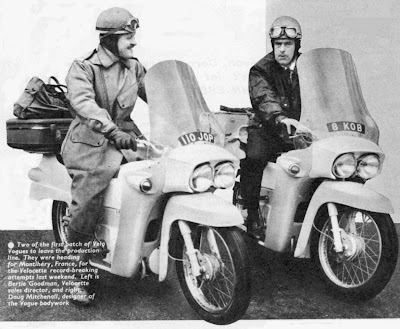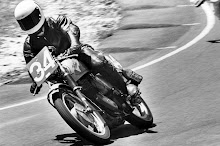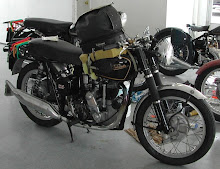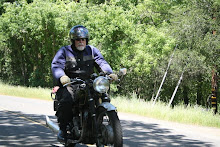I did a post on the successful attempt using a 500 Velocette Venom Clubman...the attempt over the weekend 18th and 19th March 1961, when the record was raised to 100.05mph for 24 hours.....
The absolute record was raised a week later by a 600cc BMW R69S to 109.34mph....must have been a bitter pill for BMW to be pipped as the first. There was an earlier BMW attempt that suffered mechanical problems.
Now Velocette's managing director, Bertie Goodman is no shrinking violet and took up the baton several years later using a 350cc machine....
Paul d'Orleans, The Vintagent, did a report on his webblog and it needs to be read in conjunction with this posting....
There was really little of substance in the reports in the UK motorcycling press of the time on the 350 Velocette attempt...guess Bertie Goodman was crestfallen enough and didn't elaborate in any interviews given and Bruce Main-Smith....BMS....was circumspect in his reporting.....
So what of the French who in the main financed the attempt .....
The French motorcycle magazine of the time was Moto Revue and some years back I searched for the relevant copy covering the attempt....#1652 of 27.07.1963...
For those of you who read French, the two pages are below...
Thanks Yvette....
I read it and slightly edited it to make the English sense better....
Read on....
THE 350CC VELOCETTE FAILS IN IT’S ATTEMPT AT THE WORLD RECORD
Mr. Goodman takes off his leathers, his blue
eyes do not show any disappointment: “It’s sport” he said like a good player.
And the World record of the 24hr on a 350cc
is not broken, but the 350 Velocette Clubman has in a few hours demonstrated
some interesting aspects.
The record is within reach! This record is
within reach, the 12hr perhaps a little less, and without doubt, that for
having aimed too high that M. Goodman has remounted his Velocette “LE Vogue", without the precious record in hand. But Mr. B.
Goodman is a sport, no doubt that we'll see him again in Montlhery, as before
always smiling, and always relaxed....always tenacious.
As, if the 24hr record on 500, beaten in
1961, was the work of G.Monneret, today he gave leeway to the British factory,
who has taken over the organisation, helped in this by its agent in France who
had namely the catering in hand.
However, and we had already written before
the trial, that if B.Goodman wanted a big feat, and wanting to go no faster or
no slower than the 500 with 350 -- which would have been remarkably sporting
and technically wise. -- G. Monneret, he, was more sedate and wanted simply to
break the record of 24hr fixed at 131,751 km/h.
The first hours of the trial appeared to
agree with B.Goodman.
Already, his layback ways, his lack of
urgency to begin the trials, denoted a certain trust, as well as the small
amount of "spares etc" brought along for any "mishaps". But
we also are touching on the aspects of the British temperament, and for us who
had seen the British factories for more than 15 years in Montlhery , this
layback, this famous pragmatism , is the norm and surprises the ebullient side
of our Latin avistime.
G. Monneret starts at 9.35am; it is overcast,
the wind is constant at around 5m/s, with gusts to around 7m/s, and the laps
are completed around 53seconds (say 173 km/h), in average 6.400-6.500 rpm on
the counter.... an average superior to the one maintained for the record of the
500cc. But above all, when the 350 and 500 had a same race of 86mm, the 350
with a long stroke and the 500 a square one, this time the motor held a regime
of 500rpm superior to the one of the 500.
This year, the compression ratio is 10,5 to 1
when it was 8.75 to 1 in 1961.
G.Monneret stays for more than 1 hour, hands
over the relay to B. Goodman, who resumes after a stop of 1hr3sec ; the average
is 169,693 km/h, all is well, so much so that the incorrigible G. Monneret
shows us a large hernia which is giving grief.
Goodman will average the second hour at 168,739
km/h , and will stay in the saddle for 1h30ms.
Then the laps will continue, Savoye was noted
for his good round (he had completed a round in 52sec at the trials, say
176,416 km/h), Vigreux also stayed
1h30mns at an average of 173 km/h with a
best of round of 51'8" say 177 km/h.
We started to believe G Monneret rather
prudent, and believe B.Goodman.
During 6h23min, the latter (Goodman) was
right, his 350 with "culbuteurs" (pushrod motor) maintains around an
average of 169 km/h but..........
But Terrioux, then in the saddle, came back
slowed down, no "allumage" (ignition?). It would take a bit of time
to undo a "Fil 'dallumage" (
an ignition wire?) in the magneto, and as time has elapsed, it was decided to
resume early in the morning at 4am.
In the meantime, more importantly, whilst
inspecting the machine, they found a
"goujon de fixation culasse-cylindre" (Cylinder head stud) has
broken.
4a.m. Our hopeful record seekers, as well as
sister Anne, do see anything coming.... The time keepers are absent, when
everybody else are there including Mr. H, Burik agent for FIM.
10 hours later, a time keeper arrives, this
inexcusable delay is not well looked upon, especially by Mr. Bodin chief of
course for Esso who is used to punctuality.
And the trial resumed at 10.38am, G.Monneret
starting the rounds with this time the
bandage/belt for his hernia necessary.
The Velocette returns around 53sec, but the
first hour will be completed at 163,68 km/h because the laps rarely get slower
until the end. A signal is given to Monneret to stop and B. Savoye takes over
the attempt, the laps are completed in about 53sec, then, tenths of seconds by
tenths of seconds, the time for the laps increases until the moment when
B.Savoye has just the time to catch on gearing, the motor tightened.
From then it's over, the tightening is
important. Why?
B.Goodman does not
understand in the beginning because a "gicleur" (larger jet?) was
replaced.
In fact, it is noticed then that another
"goujon" (cylinder stud) has again broken, an intake of air has occurred
at the "culasse" (cylinder head joint) this ended up in a classic
"coup de chalumeau (burning of fuel, at the end of an exhaust pipe or
stock due to excessive richness in fuel/air mixture).
The world record of the 350cc will still stay
for some time. Not long without doubt, as the Velocette team will want to take
his revenge and will probably succeed.
The 350cc Velocette Clubman is a very nice
machine, worthy of the record which it
aims at and it's not Mr. Leconte, the marque's advocate who will deny it.
THE MACHINE OF THE RECORDS
It relates to 350cc Viper Clubman prepared
for the occasion
Cylindre motot 4 strokes with " soupapes
en tete" (overhead valve)
Distribution by "tiges & culbutours
avec arbres a cane surelevers" ( camshaft and connecting rod?) to lengthen
the tiges (rod?)
This motor "long stroke" -
The Motor: long stroke - bore 72mm (stroke
& capacity of cylinders)86mm, ratio stroke/bore 1,194 developing 29cv at
7,000 t/m in the commercial version. No doubt that with the special preparation
that was bestowed on it, amongst others a respectable compression ratio of 10,5
to 1 -this motor should have developed power which was shown but the averages
reached in the first hours although the wind blew at an average of 5m/s. Nevertheless, superior speeds in the order of
190km/h were recorded in England at M.I.R.A.
Racing carburetor fitted with a long air
chamber and exhaust strong diameter ending with a "megaphone" with
inverted cone.
Noting a oiling system very particular, using
a feeding pump, a return pump, oiling being dry Carter type with a separate oil reservoir; the clever part is
that the oiling of the gear box is also Carter dry, the circulation of the oil
being assured by an side pump incorporated to the return pump of the circuit of
the oiling of the motor; common oil reservoir with oil Esso extra 20/30/40. This last
particularity is obviously special to the machine prepared for the record.
Lastly noting, a "soupape
d'echapement" (exhaust valve)
cooled by sodium .
Part standard bike, a little lighter, in fact
the one of the 500 in the earlier records: suppression of the hide
forks??(fenders?) and the back part of the frame going right to the shock
absorbers
The seat very low,did not have a back rest in
view of the different "gabarit" (form/size) of the riders.
The "carenage" (fairing) Avon,
finer than the Veeline earlier known had two small air ducts placed under the
tank without the usual fluting around the frame.
"Bulle" (Bubble) in plexiglass of
high standards, a design inspired by the "headlights" used in a few
racing machines. This headlight can be
obtained from the house of Leconte by order.
No Electric installations, the course was to
be lit.
Moyeux freins (free wheel brakes), wheels 19" fitted with Dunlop
racing 300-19" front and rear 350-19".
Tyre pressure: 2.8 kg/cm front - 3.1 kg/cm
rear which is relatively low for an attempt to the record.
Bougie (Spark plug) Marchal RR 32 HFS very
cold.
Finally the machine was fitted with two
watches solidly attached with "Chatterton" (Gaffer tape)one on the
front fork, the other on of the elements of the rear suspension. No use to the
Velocette, but a serious test of resistance
to shocks and vibrations for the two "guinea pigs" of the time
keeping industry.
So from the UK rider BMS with whom I spoke several years ago we have a slightly different angle....BMS maintained it "pinged" all the time...something that perplexed him as he found it hard to believe Bertie Goodman who rode it at the UK MIRA test track for many laps in preparation could have not experienced this....
BMS's email to me....
BMS comment, 30.09.2011
Via email to DQ
Dennis Quinlan --- I got your recorded phone call
(I was on hols in IoM) and you said you were hoping to e-mail me about the Velo
(abortive) 350 record breaker. But no e-mail has come in here.
See attached 1963 pic of myself at Montlhery.
I remarked to Hall Green mechanic Jack Passant and
to the late Bertie Goodman that it pinked. All the time it was under power it
pinked. If it was put to the task it would either eventually pull out a
cylinder stud or savage its piston. I said, kindly I hope, that they had
over-compressed it (for petrol) in an attempt to get enough bhp to pull the
very high gear (for 350cc) to keep the revs to a survivable level. So it pinked
(detonated). Behind the Mitchenall fairing this was plainly audible.
This perhaps meant they had to lower the gearing
to get the revs up & the load per power-stroke down, that in turn would
have required trying to get enough bhp to do the necessary 100+ speed, which
entails moving the max-power to higher rpm, and thus probably mechanical
failure from sustained too-high revs --- rather than mechanical-failure from
overloading at lower revs. Answer? Alcohol
Why hadn't this been reported whilst testing at
MIRA? Perhaps it had! And ignored......
So we had fingers-crossed record-attempting?
As far as I know nobody else reported on this so
maybe I am the dumb kop who scotched the 350 attempt? Rather surprised at
Bertie though, he was a very able rider and had his head on straight where
mechanical things were concerned. He should have noted it back in England,
perhaps not on the noisy York Road
dynamometer, though certainly at MIRA. But in France they did at least accept
& act on my observations.
Ivan Rhodes could redact my suppositions & no
offence taken. Send this to him? I understand Ivan doesn't do e-mail stuff
And in 2011 that is all I recall & no
secret of it (other than BJG overwhelming defeating sly Georges Monneret at the
sponsorship game)...........
Now reading the text from Moto Revue one sees it broke two cylinder studs, which BMS warned of....
I've had Velocettes since I was 16, now 68 and never heard of a cylinder head stud breaking...interestingly when the alloy 500 engine was released in 1954 it had 5/16" dia. studs, changed soon after for 3/8" dia ones and all Vipers had 3/8" studs.
But all these Velocette engines use four crankcase studs into which each cylinder stud screws into.
When we look at one of these studs, you'll note they are waisted above the thread ( 3/8" BSF ) and this diameter is only 0.300"....
The same on the 5/16" dia. and the 3/8" dia. studs.....
So the effective diameter was actually only 0.300" and it has be known for these to snap off in this waisted area and I'll bet this is what happened in the attempt.
I doubt they had spares for these as Moto Revue noted only a small amount of spares were brought along for any mishaps....
But in the time available from about 4pm to the 4am restart, either another was machined up locally in a machine shop or M.Leconte the well known French racer and Velocette dealer, who was at the attempt, would have sourced one...
The second failure was the more serious...MR noted a "tightening" of the motor.
BMS said the piston failed ...BJG was reported as saying the crown of the piston collapsed....
The compression ratio is stated as 10.5:1 by Moto Revue.
Hopefully the fuel supplied by Esso was of a suitable octane rating for this higher compression as this is a possible cause of the pinking BMS refers to....
The piston was I believe a special and could have been a Mahle...
But with a broken stud in each attempt and air being sucked in at the cylinder head joint with a possible weakness in the mixture as a result, eventually any brand of piston...whether Hepolite, Wellworthy or Mahle would have failed.....
With the two major people in the attempts, Bertie Goodman and Georges Monneret both now dead, what actually happened is just speculation.
Of interest the where-a-bouts of the 350 machine is unknown today....whereas the successful 500 was fetted and on display for years in the National Motorcycle Museum at Coventry until it was destroyed by fire...only a replica now remains, have been built by Ivan Rhodes and friends....
A possible speculation is the bike was broken up or repaired and sold as a new Viper Clubman to an unsuspecting customer....
Some interesting departures from standard are the use of a sodium filled exhaust valve when the 500 attempt 2 years earlier used a N80 nimonic austenitic exhaust value. But Velocette were no strangers to sodium valves as the used them in the factory KTT racers....I had one until recently when I passed it to Graham Roberts who bought all my KTT stuff in 1996.
The gearbox was the most radical departure from standard...it was a dry sump with oil jets and a geared pump in the endcover taking feed from the main oiltank and returning it there.
The hope was to gleen a little more bhp....
The actual BHP of the engine appears to be unknown..MR comments on the HP of the standard Viper Clubman.
So to finish off, the connundrum that still has many questions unanswered, lets view the reports in the UK magazines and some photos, courtesy of British Only Austria who have photos of the attempt from the archive of the late Peter Howdle a motorcycling journalist on Motor Cycle News....
BMS is pushed off for a stint in the first attempt on the Saturday....
BMS flatout on the Montlery banking....
BJG flatout.....
Refuelling....Reg Orpin from L.J.Stevens the Shepherd's Bush Velocette agents assists ( in black suit), BJG to right gives advice to the next rider....
Same scene from another angle.....
BMS on the banking, photo courtesy of Bruce Main-Smith
The LE referred to, above in the Moto Revue report....BJG and Doug Michenall ( owner of Avon fairings) both rode new LE Vogues to France for the record attempt.
Timing the laps..... the board shows a 52,2 second lap...175,6kph=109mph.
And finally the reference to the two watches strapped to the handlebars of the bike ...a watchmaker stumped up some sponsorship money to see the effect of prolonged vibration on the watches....
Seemed they survived the ordeal.....

























